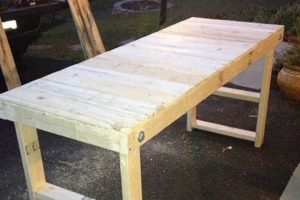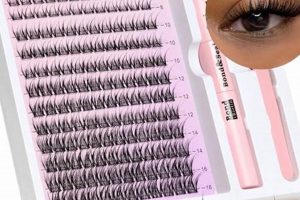A self-constructed aeration device improves gas exchange in a liquid, often water, by increasing the surface area exposed to the air. A common application involves introducing oxygen into a pond or aquarium to support aquatic life. For instance, repurposing a submersible pump and tubing to create a fountain-like effect introduces atmospheric gases into the water body.
Implementing a system for introducing air offers multiple advantages. It can prevent stagnation, reduce unpleasant odors, and create a healthier environment for fish and plant life. Historically, techniques to oxygenate water relied on natural processes, but modern methods allow for more controlled and efficient aeration, especially in closed or semi-closed aquatic ecosystems.
The following sections will detail various approaches to creating these systems, discussing factors to consider in their design and construction, and exploring common materials and tools used in their implementation. Considerations regarding energy efficiency and appropriate sizing will also be addressed.
Tips for Effective Aeration Device Construction
Constructing an aeration system requires careful planning and execution. The following tips will help ensure the device functions efficiently and maintains a healthy aquatic environment.
Tip 1: Select an Appropriate Pump. The pump’s flow rate must be matched to the water volume. Undersized pumps provide insufficient aeration, while oversized pumps can create excessive turbulence, potentially stressing aquatic life.
Tip 2: Utilize Non-Toxic Materials. Ensure all materials in contact with the water are inert and will not leach harmful chemicals. Food-grade plastics and stainless steel are often suitable choices.
Tip 3: Optimize Diffuser Design. The diffuser breaks up air into fine bubbles, maximizing surface area for gas exchange. Consider using air stones, porous tubing, or specialized diffusers to improve efficiency.
Tip 4: Implement Pre-Filtration. Install a filter on the pump intake to prevent debris from clogging the system. This will maintain flow rate and reduce maintenance requirements.
Tip 5: Position the Aerator Strategically. Place the aerator in an area with good water circulation to ensure uniform oxygen distribution. Avoid stagnant zones.
Tip 6: Consider Energy Efficiency. Selecting an energy-efficient pump and optimizing the system design can reduce operating costs. Explore solar-powered options for remote applications.
Tip 7: Monitor Oxygen Levels. Regularly test the water’s dissolved oxygen levels to ensure the aeration system is performing adequately. Adjust the flow rate or diffuser design as needed.
Effective device construction involves careful material selection, proper sizing, and strategic placement. Adhering to these guidelines will optimize performance and contribute to a thriving aquatic environment.
The subsequent sections will explore the maintenance requirements and troubleshooting common issues associated with these systems.
1. Water Volume
Water volume is a foundational consideration in aeration system design. The size of the aquatic environment directly dictates the necessary aeration capacity. An insufficient system will fail to adequately oxygenate the water, leading to detrimental effects on aquatic life, while an oversized system can be inefficient and potentially disruptive.
- Oxygen Demand
Larger water bodies possess a higher oxygen demand due to increased biomass and decomposition rates. Consequently, aeration systems must be scaled to meet these elevated needs. For example, a small backyard pond requires significantly less aeration than a commercial aquaculture tank.
- Pumping Capacity
Pump selection is intrinsically linked to water volume. The pump’s flow rate, measured in gallons per hour (GPH) or liters per hour (LPH), must be sufficient to circulate the entire volume within a reasonable timeframe. An undersized pump will result in inadequate oxygen distribution, creating stagnant, oxygen-depleted zones.
- Diffuser Sizing and Placement
The size and number of diffusers are also dependent on water volume. Larger volumes often necessitate multiple diffusers strategically placed to ensure uniform oxygenation throughout the water body. Proper diffuser placement prevents dead spots and maximizes the efficiency of gas exchange.
- Detritus Accumulation
Larger water volumes tend to accumulate more organic detritus, which contributes to oxygen depletion as it decomposes. Efficient aeration is essential for mitigating the negative effects of detritus accumulation by promoting aerobic decomposition and preventing anaerobic conditions that lead to the production of harmful gases like hydrogen sulfide.
Therefore, a thorough assessment of water volume is paramount before embarking on aeration device construction. Accurate volume calculation and subsequent system design based on this calculation are critical for maintaining a healthy and balanced aquatic ecosystem.
2. Pump Selection
Pump selection is a critical determinant of performance for a constructed aeration device. The pump provides the motive force to introduce air into the water, dictating the volume of air delivered and influencing the size of the bubbles created. Inadequate pump capacity results in insufficient oxygenation, potentially leading to anoxic conditions. Conversely, an excessively powerful pump can generate undesirable turbulence, stressing aquatic organisms. For example, a small pond utilizing a repurposed fountain pump might experience excessive surface agitation, while a large aquaculture tank with an underpowered air pump might exhibit oxygen stratification.
The pump’s characteristics, including flow rate, pressure, and energy consumption, directly affect the efficiency and operational cost of the constructed aeration system. Submersible pumps, often chosen for their ease of installation, must be rated for continuous duty and constructed of materials compatible with the aquatic environment. Air pumps, common in smaller aquariums, require careful sizing to match the air diffuser’s resistance. The choice between a diaphragm pump, regenerative blower, or piston pump depends on the specific aeration requirements and budget constraints. Practical understanding of pump curves and power consumption data enables informed decision-making during device construction.
Ultimately, appropriate pump selection dictates the effectiveness and sustainability of the self-constructed aeration device. Incorrect pump sizing leads to either biological imbalances or wasted energy. Thorough assessment of the aquatic environment’s oxygen demand, coupled with a comprehensive understanding of pump characteristics, is paramount for achieving optimal aeration. The careful selection process
enables a balanced and healthy aquatic ecosystem to thrive while keeping operational costs at bay.
3. Diffuser Type
Diffuser type represents a pivotal element in the design and construction of any aeration system. The diffuser’s primary function is to break down air into smaller bubbles, maximizing the surface area for gas exchange between the air and water. Effective diffuser selection directly impacts the overall oxygen transfer efficiency of the aeration device.
- Air Stone Diffusers
Air stone diffusers, often constructed from porous materials such as ceramic or bonded silica, create a stream of fine bubbles. Their relatively low cost and ease of integration make them a popular choice for smaller aeration applications. However, air stones can become clogged over time, requiring periodic cleaning or replacement to maintain optimal performance. Their efficiency is also limited compared to other diffuser types.
- Porous Hose Diffusers
Porous hose diffusers consist of flexible tubing with small perforations along its length. These diffusers offer greater surface area for bubble formation compared to air stones, resulting in improved oxygen transfer rates. They are well-suited for larger tanks or ponds where a wider distribution of air is required. The flexible nature of the hose allows for customized placement and adaptation to varying bottom contours.
- Disc Diffusers
Disc diffusers typically incorporate a flexible membrane with numerous small slits. Air forced through the membrane causes the slits to open, creating a uniform distribution of fine bubbles. These diffusers are known for their high oxygen transfer efficiency and resistance to clogging. While generally more expensive than air stones or porous hoses, disc diffusers offer superior performance and longevity in demanding applications.
- DIY Diffusers
Creative approaches involve repurposing materials to construct diffusers. An inverted bottle with small holes, weighted down to sit on the bottom of an aquatic environment, is one example. While cost-effective, these often lack the consistency and efficiency of commercially produced options. The material selection and construction methods are critical to avoid leaching toxins or creating uneven bubble distribution.
The selection of an appropriate diffuser type hinges on factors such as water volume, oxygen demand, budget, and desired level of performance. Careful consideration of these variables will ensure that the constructed aeration device delivers optimal oxygenation for a thriving aquatic ecosystem. The subsequent aspects will detail material safety and how it ties into the creation of aeration devices.
4. Material Safety
Material safety is paramount in the design and construction of any aeration device intended for aquatic environments. The selection of non-toxic, chemically inert materials is crucial to prevent the leaching of harmful substances into the water, which could negatively impact aquatic life and disrupt the delicate ecosystem balance.
- Plastic Composition
Many systems incorporate plastics for tubing, connectors, and structural components. The type of plastic used is critical. PVC (polyvinyl chloride), while commonly available, can leach plasticizers and other additives harmful to aquatic organisms. Food-grade polyethylene (PE) or polypropylene (PP) are often preferable due to their relative inertness and reduced risk of contamination. For example, using PVC tubing in a fish tank could lead to the accumulation of harmful chemicals, impacting fish health and reproduction. Rigorous assessment of plastic composition and potential leaching is essential.
- Metal Corrosion
The use of metallic components, such as fasteners or submersible pump housings, introduces the risk of corrosion and metal ion release. Iron, copper, and zinc, even in small concentrations, can be toxic to aquatic life. Stainless steel offers improved corrosion resistance compared to galvanized steel or other common metals. Careful selection of corrosion-resistant alloys and avoidance of dissimilar metal contact can minimize the risk of metal contamination. An example of this is where using standard steel bolts in a pond setup can cause rust to contaminate the water over time.
- Sealant Compatibility
Sealants and adhesives are often employed to create watertight connections in aeration systems. Many commercially available sealants contain solvents or other chemicals that can leach into the water. Aquarium-safe silicone sealants, specifically formulated for aquatic applications, should be used to ensure compatibility and minimize the risk of contamination. Thorough curing of the sealant before introducing the device into the water is also critical. Using the wrong type of sealant can introduce dangerous chemicals into the aquatic ecosystem.
- Paint and Coating Toxicity
If any part of the constructed device is painted or coated, it is imperative to select paints and coatings that are certified as non-toxic and aquarium-safe. Many conventional paints contain heavy metals or volatile organic compounds (VOCs) that can be detrimental to aquatic organisms. Ensure that the chosen coating is fully cured and inert before submerging the device in water. An example is that regular paint can contain harmful substances such as lead.
Therefore, attention to material safety is non-negotiable when constructing an aeration device. The use of appropriate materials prevents pollution and ensures the well-being of the aquatic environment. Selecting materials with verifiable safety certifications ensures a sustainable, healthy environment for aquatic life. Furthermore, the responsible use of materials strengthens the benefits derived from these aeration systems.
5. Energy Efficiency
Energy efficiency is a central consideration in the design and operation of aeration devices, especially when constructed at home. Operational costs associated with continuous aeration can be significant, making efficient design crucial for long-term sustainability and economic viability.
- Pump Selection and Sizing
Selecting an appropriately sized pump is vital for minimizing energy consumption. An oversized pump consumes more power than necessary, while an undersized pump may not provide adequate aeration. Choosing a pump with a high efficiency rating, often expressed as flow rate per watt, can significantly reduce energy costs. For instance, replacing an old, inefficient pump with a modern, energy-efficient model can result in substantial savings over time. Proper pump selection is foundational for an energy-efficient aeration system.
- Diffuser Type and Placement
Diffuser type plays a crucial role in oxygen transfer efficiency. Fine bubble diffusers generally offer higher oxygen transfer rates compared to coarse bubble diffusers, requiring less energy to achieve the same level of aeration. Strategic placement of diffusers can also improve efficiency by minimizing dead zones and promoting uniform oxygen distribution. Dire
ct placement of diffusers to maximize their dispersion and reach is also critical. Optimized placement of diffusers will ensure greater effectiveness. - Timer and Sensor Integration
Implementing a timer or sensor-based control system can further enhance energy efficiency. Aeration may not be required continuously, particularly during periods of low oxygen demand. A timer can be used to schedule aeration cycles, while sensors can monitor dissolved oxygen levels and activate the aeration system only when necessary. The use of these technologies prevents energy waste. For example, a dissolved oxygen sensor can activate the aeration system only when oxygen levels fall below a predetermined threshold.
- Alternative Energy Sources
Exploring alternative energy sources, such as solar power, can significantly reduce reliance on grid electricity. Solar-powered aeration systems utilize photovoltaic panels to generate electricity for the pump, eliminating energy costs and reducing environmental impact. While the initial investment may be higher, the long-term savings and environmental benefits can be substantial. Solar panels help to cut the carbon footprint and reduce utility bills.
Considering these various facets of energy efficiency contributes to the sustainability of aeration practices. Careful planning and conscious selection of components will result in systems that are both economically viable and environmentally responsible. Improving operational costs makes them viable. Also, choosing the correct components can make a difference.
6. Maintenance
Consistent maintenance is integral to the sustained performance and longevity of a self-constructed aeration device. Neglecting routine upkeep compromises efficiency, increases the risk of component failure, and may ultimately negate the intended benefits of improved water quality. A proactive maintenance regimen ensures the device operates optimally and extends its lifespan.
- Pump Inspection and Cleaning
The pump constitutes the core of most aeration systems, and its proper functioning is paramount. Periodic inspection for debris accumulation, impeller blockages, and unusual noise is necessary. Cleaning the pump intake filter prevents reduced flow rates and potential motor burnout. In submersible pumps, checking for seal integrity prevents water intrusion and electrical hazards. For example, mineral buildup can impede impeller function, diminishing the pump’s ability to circulate water effectively. Adhering to manufacturer-recommended maintenance schedules is highly advised.
- Diffuser Cleaning and Replacement
Diffusers, responsible for generating air bubbles, are prone to clogging due to sediment, algae growth, and mineral deposits. Regular cleaning, typically involving soaking in a diluted acid solution or manual scrubbing, is essential for maintaining optimal bubble size and distribution. Over time, diffuser membranes may degrade or become irreparably clogged, necessitating replacement. Failing to address diffuser maintenance can significantly reduce oxygen transfer efficiency, undermining the aeration process. Algae accumulation reduces air flow, resulting in less oxygen reaching aquatic species.
- Tubing and Connection Inspection
Tubing and connections are susceptible to leaks, cracks, and disconnections, particularly in outdoor or submerged environments. Regular inspection for these issues is crucial for preventing air loss and maintaining system pressure. Replacing deteriorated tubing and tightening loose connections ensures efficient air delivery to the diffuser. UV exposure can weaken tubing, leading to cracks and leaks. Routine checks of all connections and tubing ensure a properly sealed system that maximizes aeration effectiveness.
- Electrical Component Monitoring
The electrical components of the aeration system, including power cords, plugs, and timers, require periodic monitoring for damage or corrosion. Damaged cords pose a safety hazard and should be replaced immediately. Corroded connections can impede electrical conductivity, reducing pump performance. Ensuring that all electrical connections are properly grounded and protected from moisture minimizes the risk of electrical shock or equipment failure. For example, exposed wiring near water presents a significant safety risk. Careful attention to the condition of electrical components safeguards both the user and the aquatic ecosystem.
The consistent adherence to a comprehensive maintenance schedule is critical for maximizing the return on investment in a self-constructed aeration device. By diligently addressing potential issues, its long-term effectiveness is ensured, and the health of the aquatic environment it supports is promoted. The long-term health of this kind of ecosystem is supported.
7. Placement
The positioning of an aeration device fundamentally influences its effectiveness within an aquatic environment. Strategic placement maximizes oxygen distribution, minimizes stagnant zones, and optimizes the energy efficiency of the system. Improper placement leads to uneven oxygen levels, reduced water quality, and potentially increased operational costs. For instance, positioning a device solely in one corner of a large pond will create a localized oxygenated area, leaving the majority of the water body inadequately aerated. Conversely, placing the aerator directly in the deepest part of a stratified lake can disrupt thermal layers, causing unintended ecological consequences. Therefore, a well-considered deployment strategy is crucial.
Different types of aquatic environments necessitate varying placement approaches. In aquariums, the device may be positioned near the substrate to prevent detritus accumulation or near the water surface to maximize surface agitation and gas exchange. In ponds and lakes, multiple diffusers strategically distributed throughout the water body are often required to achieve uniform oxygenation. Additionally, factors such as water depth, flow patterns, and the presence of obstructions must be considered. For example, placing an aerator behind a large rock formation will create a shaded, stagnant zone with reduced oxygen levels. Understanding the specific characteristics of the aquatic environment allows for tailored positioning that enhances aeration effectiveness.
In summary, the proper placement of aeration devices is a critical determinant of their overall success. It directly impacts oxygen distribution, energy efficiency, and the health of the aquatic ecosystem. Thoughtful consideration of environmental factors, water dynamics, and the specific requirements of the system ensures that the benefits of aeration are fully realized. Overlooking the significance of placement undermines the entire aeration effort. Furthermore, the practical benefits of an expertly positioned system are healthier aquatic populations and clearer water, minimizing the need for further intervention.
Frequently Asked Questions
This section addresses common inquiries concerning the design, construction, and maintenance of self-built aeration devices. The following questions and answers provide concise guidance to ensure proper function and ecological responsibility.
Question 1: What is the optimal flow rate for an aeration device in a pond?
The appropriate flow rate depends on pond volume,
aquatic biomass, and desired oxygen levels. A general guideline suggests circulating the entire pond volume once every 1-2 hours. However, monitoring dissolved oxygen levels remains the most reliable method for determining optimal flow.
Question 2: How often should diffusers be cleaned?
Diffuser cleaning frequency varies based on water quality and sediment load. Visual inspection is recommended monthly, with cleaning performed when bubble production noticeably decreases. In heavily sedimented water, cleaning may be required more frequently.
Question 3: What types of materials should be avoided in construction?
Materials that leach harmful chemicals, such as untreated PVC, galvanized steel, and certain plastics, should be avoided. Opt for food-grade plastics, stainless steel, or aquarium-safe alternatives to prevent water contamination.
Question 4: Can aeration devices be powered by solar energy?
Yes, solar-powered aeration systems are feasible. The size of the solar panel and battery system must be appropriately matched to the pump’s energy requirements. Solar aeration offers a sustainable and cost-effective solution for remote locations.
Question 5: What are the signs of inadequate aeration?
Signs of insufficient aeration include sluggish fish behavior, surface gasping, foul odors, excessive algae growth, and elevated ammonia or nitrite levels. Regular water quality testing helps detect and address aeration deficiencies.
Question 6: How should an aeration device be winterized in cold climates?
In regions with freezing temperatures, removing the pump and diffuser to prevent damage is recommended. Allowing a portion of the pond surface to freeze over while maintaining a small open area for gas exchange can also be beneficial.
Proper construction and ongoing maintenance are essential for maximizing the effectiveness of these systems. Careful monitoring of water quality and prompt response to any issues contributes to a healthy aquatic environment.
The subsequent section will provide resources for further information and guidance.
Concluding Remarks on Aeration Device Construction
The preceding discussion explored the diverse considerations involved in aeration device construction. Essential aspects include water volume assessment, strategic pump selection, appropriate diffuser implementation, and stringent adherence to material safety guidelines. Energy efficiency and diligent maintenance practices further contribute to the long-term viability and effectiveness of these systems.
The construction and implementation of a functional system necessitates a commitment to responsible design and execution. Aquatic ecosystems depend on well-oxygenated environments for their continued health and stability. Therefore, continued vigilance and informed practices are crucial for ensuring the benefits of aeration are realized sustainably, promoting a thriving aquatic ecosystem.







